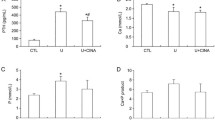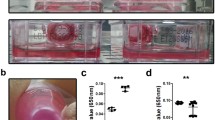Abstract
In recent years, it is found that increase in Hcy level in blood can directly or indirectly cause vascular endothelial cell injury and induce vascular calcification. However, the mechanism of vascular endothelial cell injury and vascular calcification has not been studied thoroughly. This paper carried out experiment for research aiming at discussing the effect and action mechanism of Hhcy on endothelial cells and vascular calcification. Firstly, human umbilical vein endothelial cells (HUVECs) were cultured and then intervened by Hcy of different concentrations (0, 0.01, 0.1, 1.0, 3.0, 5.0 mmol/L) and at different action time (3, 6, 12, 24 h). Then apoptosis rate and reactive oxygen were detected by flow cytometry. At the same time, the model for the culture of rat vascular calcification was set up and induced into Hhcy so as to detect the total plasma Hcy level and judge vascular calcification degree. The results showed that with the increase in Hcy concentration and extension of action period, the apoptosis rate and generation of reactive oxygen of HUVECs all significantly increased, and the differences were all statistically significant (P < 0.01). In animal calcification model, mass of black particle deposition was seen after Von Kossa staining of rat vessels in calcification group. Compared with the control group, the vascular calcium content, alkaline phosphatase activity and osteocalcin content in calcification group all increased (P < 0.01). The content of plasma lipid conjugated olefine from highest to lowest wasas follows: calcification plus homoetheionin, homoetheionin, and calcification group. There was no significant difference between the calcification group and control group. All these findings suggested that Hcy could induce the apoptosis of endothelial cells and its effect degree depended on its concentration and action period; Hhcy could promote the calcification of blood vessels, and its mechanism might relate with the strengthening of lipid peroxidation. The above results leave great benefits on clinical prevention works.


Similar content being viewed by others
References
Wang YK, Zhao H, Zhai QQ, Wang YY, Guo SY. The study of clinical characteristics of cerebral infarction with hyperhomocysteinemia. J Brain Nerv Dis. 2010;50(1):55–60.
Han P. The relationship between plasma homocysteinemia and cerebral infarction [J]. China Health Ind. 2013;19:130–1.
Li L, Hu BC, Gong SJ, et al. Homocysteine induced caspase-3 activation by endoplasmic reticulum stress in endothelial progenitor cells from patients with coronary heart disease and healthy donors. Biosci Biotechnol Biochem. 2011;75:1300–5.
Chen CX, Cao CF, Song CX. Influence of Hhcy and hyperinsulinism on human endothelial cell apoptosis and caspase-3 expression. Chin Rem Clin. 2012;12(10):1289–91.
Xue Y, Lin S, Jia JY, Yan TK. Cardiovascular calcification in diabetic nephropathy patients in uremic stage and analysis on its risk factors. J Jilin Univ (Med Ed). 2010;36(5):946–51.
Zhao MX, Zhu JC, Cai J, Gao XF, Chen SL. Homocysteine and coronary heart disease [J]. Prog Mod Biomed. 2013;13(15):2983–5.
Wang XQ, Tian XJ, Zhang SW. Correlational study of the hyperhomocysteinemia and cerebral infarction [J]. China Mod Med. 2012;19(8):29–30.
Lehman SJ, Massaro JM, Schlett CL, et al. Peri-aortic fat, cardiovascular disease risk factors, and aortic calcification: the Framingham heart study. Atherosclerosis. 2010;210(2):656–61.
Zhang YJ, Zhang XS, Wei RH, et al. Elevated expression of urotensin II and its receptor in vascular calcification of rats. Chin J Arterioscler. 2010;18(7):505–9.
Tao SQ, Xu SH, Chao Y, Zheng XX, Xie LD, Xu CS. The effects of advanced glycation end products and homocystein on the expression of vascular cell adhesion molecule-1 via NADPH oxidase in human umbilical vein endothelial cell. Chin J Arterioscler. 2010;18(1):20–4.
Li WG. Retrospective analysis of effect of Hcy in patients with acute coronary syndrome on blood platelet activity and endothelial cell. J Guiyang Coll Tradit Chin Med. 2012;34(3):54–5.
Shan Y, Zhang MH, Zhang M, Tian XY. Effect of homocysteine on the expression of endothelial antioxidative enzymes in vein. J Yunan Norm Univ (Nat Sci Ed). 2011;31(3):64–7.
Chen FH, Feng DM. Anti-TL1A-Ab preventing high glucose-induced human vascular endothelial cell apoptosis through ROS inhibition. Jilin Med J. 2010;31(25):4229–31.
Shi Y, Zhou YB, Cai Y. Effect of age on vascular calcification induced by viatamin D3 and nicotine. J Beijing Univ. 2010;42(2):131–6.
Wang LX, Zheng LL, Li C. Relationship between osteocalcin and atherosclerosis. J Med Forum. 2011;32(1):200–2.
Rai B, Kaur J, Catalina M, et al. Bone mineral density, bone mineral content, gingival crevicular fluid (matrix metalloproteinases, cathepsin K, osteocalcin), and salivary and serum osteocalcin levels in human mandible and alveolar bone under conditions of simulated microgravity. J Oral Sci. 2010;52(3):385–90.
Yang HY. Relationships of serum 25-hydroxyl vitamin D and lipid peroxidation on elder carotid atherosclerosis. Anhui: Anhui Medical University; 2014.
Conflict of interest
We declare that we have no conflict of interest.
Author information
Authors and Affiliations
Corresponding author
Rights and permissions
About this article
Cite this article
Fang, K., Chen, Z., Liu, M. et al. Apoptosis and calcification of vascular endothelial cell under hyperhomocysteinemia. Med Oncol 32, 403 (2015). https://doi.org/10.1007/s12032-014-0403-z
Received:
Accepted:
Published:
DOI: https://doi.org/10.1007/s12032-014-0403-z




